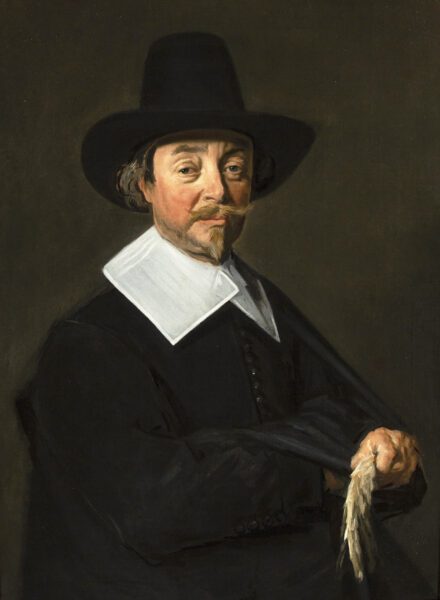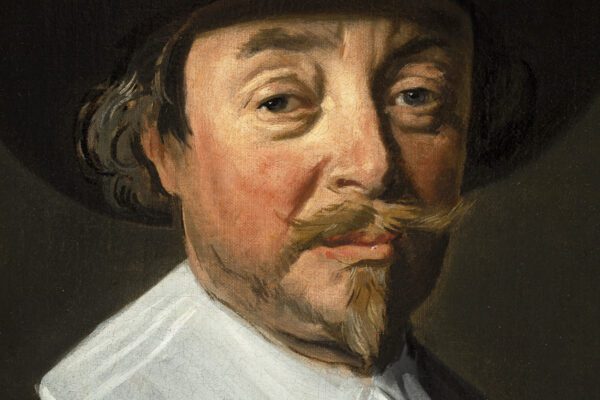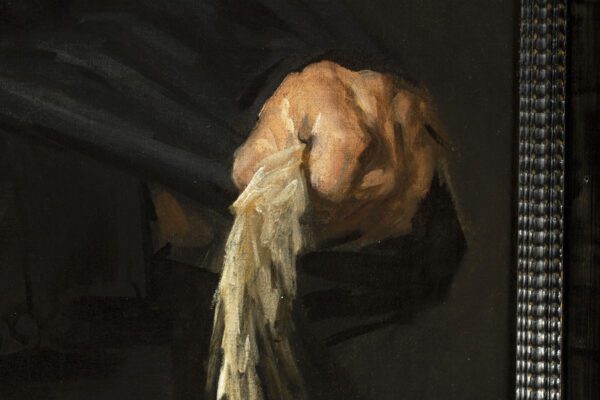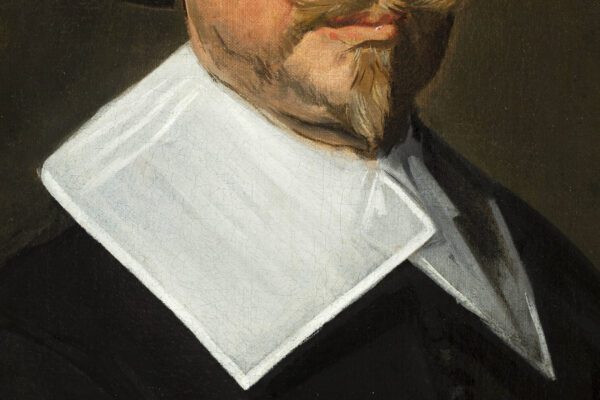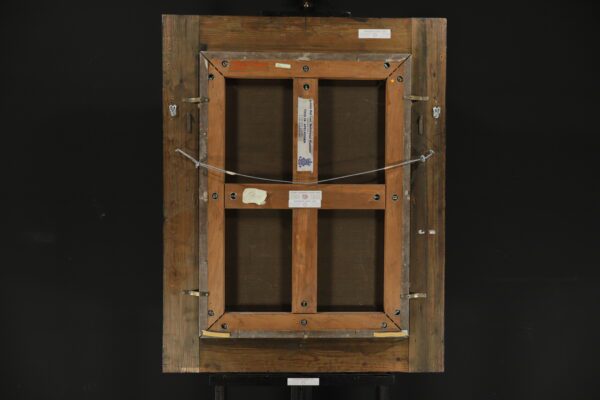“Portrait of a Gentleman, in black, wearing a hat” (‘The Hotinov Hals’)
Oil on canvas: 88 x 65 cm; to be dated 1644/45
RKD Study, Claus Grimm, 2024: no. A1.110
This current portrait is numbered A1.110 and is thus one of the very rare portraits executed entirely by the master himself that is still in private collection.
This important portrait was painted by the most famous portrait painter of the Golden Age and one of the greatest names in art history. Indeed, it has an intriguing history. Frans Hals (1582/83-1666) is one of the most important Dutch masters of the seventeenth century. The Haarlem painter became well known for his striking portraits, colorful genre paintings and large civic guard portraits, but also through the enormous influence he had on 19th and early 20th century artists as well as on the development of modern painting in general.
The Rediscovery
To begin with, it is the most newly discovered painting by the great Haarlem master. The Hotinov’s, from Muiderberg, presented the painting on the 13th May 1964 to the director of the museum in Haarlem, which is, in fact, named after the world-famous painter himself, the Frans Hals Museum.
The Hotinov’s bought the portrait at a small auction the previous year in the sales room of J.C. Derksen in Arnhem for Dfl. 40,25 (equivalent of $7 then). They had the painting restored by a coarse and rogue restorer, who after cleaning concluded that he was dealing with a Frans Hals. He then decided to paint over the canvas in such a way that it was no longer visible that it was an original, with the apparent intention of purchasing the portrait from the Hotinov’s, in the hope that the painting would then, after removal of the overpaints, be able to resell at a large profit. The Hotinov’s, however, had been warned in the meantime and did not accept the proposal. They then entrusted the painting to the care of an honest, but nonetheless rather incompetent restorer, to remove the overpainting.
It was in this state that the then director of the Frans Hals Museum, Dr. H.P. Baard, looked at the piece in 1964 (Illustration 1 & 2). Baard noted that its frame dated from the 1860s, and he thought the repainting had probably been done at the same time or around 1870, perhaps to give it a more finished appearance, in accordance with the taste of the time. He exhibited the painting in the Museum so that experts could form an opinion and almost all of them concluded that it was a real Frans Hals. The discovery of such a monumental painting was received with an almost ecstatic disbelief. The moments of such incredible discoveries are rare! And soon an X-ray examination showed that the material was old and after professional restoration in the studio of the Frans Hals Museum, there was no doubt whatsoever about Hals ‘authenticity.
In the meantime, a German buyer presented herself. She stipulated two conditions, however, (1) that the painting be cleaned by the restorer of the Frans Hals Museum itself, and (2) that the most prominent Frans Hals expert, Prof. Seymour Slive, give his verdict.
This is a mature work by Frans Hals, painted circa 1644-5, a dating with which both Seymour Slive and Claus Grimm concur. Slive compares the treatment of the head and collar and the overall tonality with Hals’ undated Portrait of a Man in Edinburgh, National Gallery of Scotland, which he in turn relates to works dated 1643 and 1644, and dates it between 1643 and 1645.
The hand of the sitter is painted in typical Frans Hals style. Sometimes Frans Hals’ hands barely look like hands up-close. From a distance, however, it appears that few artists have painted such expressive and lifelike hands as his. One can see the blood flowing through the veins, if you will. In this context, for example, look at the black shadow of the index finger which, contrasted with the light spots on the other side of the finger, the side from which the light comes, results in a beautiful spatial effect.
The latest catalogue raisonné from 2024 with extensive research done by Claus Grimm in conjunction with the RKD Netherlands Institute for Art History is divided according to the type and the degree of involvement of Hals, and of other hands respectively. A total 344 paintings including his workshop and collaborations are currently know.
Within the corpus of original paintings there are different categories, depending on the degree of the master’s involvement. Category A1 comprises paintings (131) that are autograph work by Hals and that were either executed only by him, or reworked by him throughout. The paintings (14) in category A2 are partly autograph and created in collaboration with other masters from outside of Hals’s workshop. Category A3 comprises paintings (67) that were partly created by the master and partly by assistants, while category A4 covers creations (132) by the workshop which do not show Hals’s ‘handwriting’, yet which were made on the basis of his design and preparatory sketches. The latter category is subdivided in three groups: A4.1 for small pictures painted after Hals’s templates for engravings (18), A4.2 for genre paintings (59), and A4.3 for portraits (55).
This current portrait is numbered A1.110 and is thus one of the very rare portraits executed entirely by the master himself that is still in private collection.
Provenance
- Hofman, Zutphen, Holland, by around 1930;
- By whom sold to M.C. van Mourik, Huize Midwijk, Vorden in around 1930;
- By marriage to his widow M.C. van Mourik-Spoor, Huize Midwijk, Vorden;
- By whom sold in 1962 to Th. J. van Beukering, Arnhem;
- By whom entered for sale at Arnhem, J.C. Derksen, 19 July 1963, but sold outside of the auction;
- Whence acquired, on 19 July 1963, by Mr and Mrs Leonid Hotinov, Muiderberg, for 40 florins and 25 stuivers;
- By whom sold to Mrs Gisela Kemperdick, Kaster, Amt Bedburg near Cologne;
- By whom sold, London, Christie’s, 26 November 1965, lot 70, for £73,500;
- Where acquired by Walter Goetz for the Kimbell Art Foundation, Fort Worth;
- Kimbell Art Museum, Fort Worth, Texas (inv. AP 65.2);
- By whom de-accessioned by private sale in 1993;
- Private collection, England;
- With Johnny van Haeften, London, from whom acquired by a private Dutch collector, in 2004;
- Sotheby’s, London 2010;
- with Douwes Fine Art, Amsterdam 2011;
- private collection, The Netherlands.
Exhibited
- Haarlem, Frans Hals Museum, on loan, April – May 1965.
- Kimbell Art Museum, Fort Worth, Texas, USA, 1966-1992.
- TEFAF ‘The European Fine Art Fair’, Maastricht, 18 – 27 March 2011;
- ‘Uit de kunst!, 100 jaar Nederlandse kunsthandel’, Het Loo Palace, Apeldoorn, november 2011;
- ‘Artist IQ 500 jaar Kunst’, Beurs van Berlage, Amsterdam, 17 Jan – 1 Feb 2015.
Literature
- G.C. Vieten, “Ehrenrettung für Frans Hals,” in Die Weltkunst, 34, 1964, no. 23, 15 November, p. 990;
- G.C. Vieten, “Der unbekannte von Haarlem,” in Die Weltkunst, 35, 1965, no. 10, 15 May, p. 403, reproduced;
- H.P. Baard, “Wedergeboorte en lotgevallen van de “Hotinov-Hals”‘, in Oud Holland, 80, 1965, pp. 211-19;
- Slive, Frans Hals, vol. II, London 1970, reproduced fig. 241, vol. III, London 1974, pp. 80-81, no. 158, reproduced fig. 37 (before restoration);
- Grimm, Frans Hals: Entwicklung, Werkanalyse, Gesamtkatalog, Berlin 1972, pp. 105 & 204, no. 123, reproduced figs. 135 & 141;
- Museum Catalogue, Kimbell Art Museum. Catalogue of the Collection, Fort Worth 1972, pp. 55-56, reproduced;
-
Museum Catalogue, Kimbell Art Museum. Handbook of the Collection, Fort Worth 1981, p. 58, reproduced;
- P.C. Sutton, A Guide to Dutch Art in America, Grand Rapids & Kampen 1986, pp. 91-2;In Pursuit of Quality. The Kimbell Art Museum. An Illustrated History of the Art and Architecture, Fort Worth 1987, p. 212, reproduced;
- Grimm & E.C. Montagni, L’opera completa di Frans Hals, Milan 1974, p. 104, no. 160, reproduced p. 103;
- Grimm, Frans Hals. Das Gesamtwerk, Stuttgart & Zürich 1989, p. 281, no. 124, reproduced;
- Grimm, Frans Hals. The Complete Work, New York 1990, p. 287, no. 124, reproduced.
-
to be published in RKD Study: Claus Grimm, ‘Frans Hals and his workshop’, 2023-2024, no. A1.110, as executed entirely and only by Frans Hals himself.
